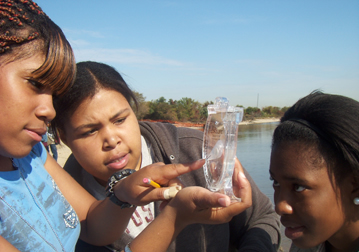“Day in The Life of The Hudson River”
Connects Students to The Hudson River Estuary
Thousands of students, from first graders to college undergrads, will partner with environmental education centers on Thurs Oct 10 to collect scientific data all along the tidal Hudson to create a snapshot of the river at dozens of locations. The Hudson River Estuary Program has recruited and trained river educators to work with students at each site. Locally, Columbia University’s Lamont-Doherty Earth Observatory will be hosting observations and data collection at the Piermont Pier from 9a-2p.
During “Day in the Life of the Hudson River” participants don waders and catch fish and invertebrates in seine nets, track the river’s tides and currents, and examine water chemistry and quality. More than a field trip, “Day in the Life” allows students to use hands-on field techniques to describe their communities’ natural resources, and explore how their piece of the river fits into the larger ecosystem. Findings are posted online within a few days of the event.
Now in its eleventh year, “Day in the Life” is sponsored by NYS DEC’s Hudson River Estuary Program, in partnership with the National Estuarine Research Reserve, the Lamont-Doherty Earth Observatory of Columbia University, and Cornell’s NYS Water Resources Institute. “Day in the Life” coincides with National Estuaries Day and World Water Monitoring Day.
“This is a great example of the kind of project enabled by the NYS Environmental Protection Fund” said DEC Commissioner Joe Martens. “The Day in the Life” annual event enables students to experience firsthand how fish diversity relates to their local waterway. Students also learn how upriver communities connect to downriver ones, and that the watershed and the coast are part of a shared system that so many New Yorkers can benefit from.”
Estuary staff will connect the field day with the classroom by conducting pre- and post-visits in 15 schools that will participate in “Day in the Life.” Lessons on-site and in the classroom fulfill NYS learning standards in a variety of subjects. This year, students will be taught to use the Hudson River Environmental Conditions Observing System (HRECOS), a computerized network of real-time monitoring stations on the Hudson River Estuary from Shodack Island to the New York/New Jersey harbor. Dissolved oxygen levels, water temperature turbidity, and other parameters are measured by HRECOS every 15 minutes and posted on the World Wide Web.
“Participation in ‘A Day in the Life’ is a great way to inspire my sixth graders to become future scientists. It helps them to better comprehend the delicate balance between the natural world, living organisms and human beings,” said Phil Levine of Irvington Middle School.
The anticipated participation in this year’s event will bring the total number of students, educators, and volunteers involved to more than 23,700 since 2003. Armed with seine nets and minnow pots, they’ve caught over 18,600 fish of 54 species, ranging from the abundant Atlantic silverside (4,898 over 10 years) to the odd summer flounder, lined seahorse and spotted hake, each caught only once. The striped bass has been one of the species caught at the most sites, from Manhattan’s saltwater piers to Columbia County’s freshwater shore. Once in decline coast-wide, stripers have rebounded to a prosperous recreational fishery thanks in part to DEC efforts.
Students examine the physical and chemical aspects of the river with a wide range of equipment and contraptions, like a home-made sediment corer assembled from local hardware supplies. High-tech refractometers and simple plastic hydrometers can both be used to measure salinity and find the “salt front” – the leading edge of dilute seawater pushing up the estuary. Daily monitoring of the salt front’s location ceased when funding cuts forced the shutdown of federal government monitoring stations, but the data collected on Day in the Life does pinpoint its location on this one day each year. In dry years, the salt front may push its way to Poughkeepsie, while in wet years heavy rains have flushed the saltwater all the way down to Croton Point.
Source: NYS DEC









